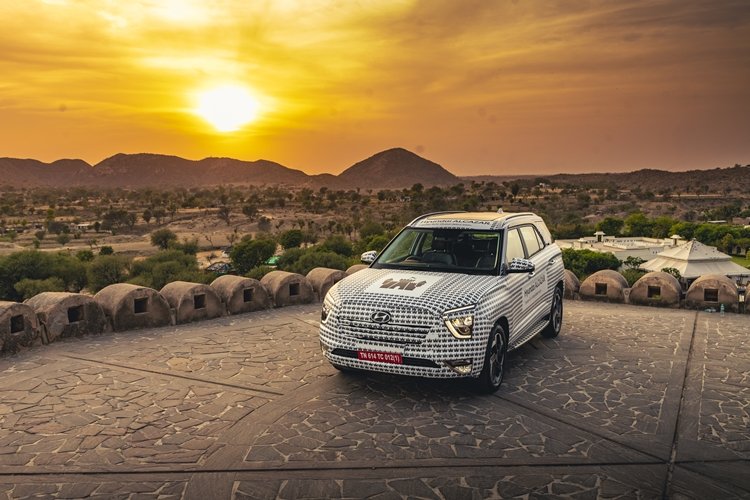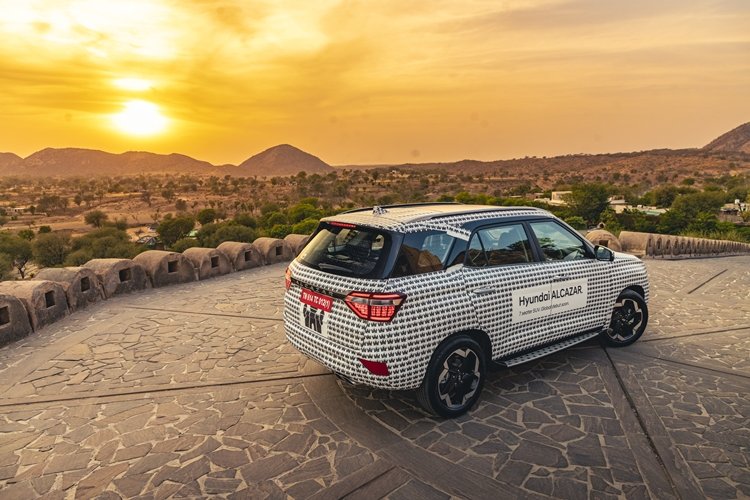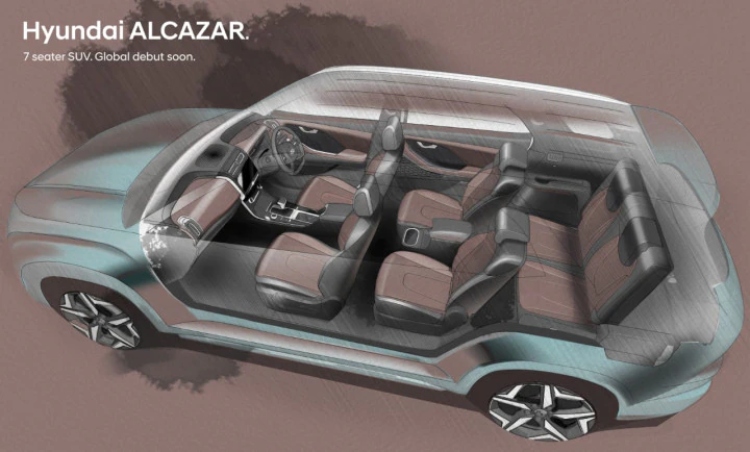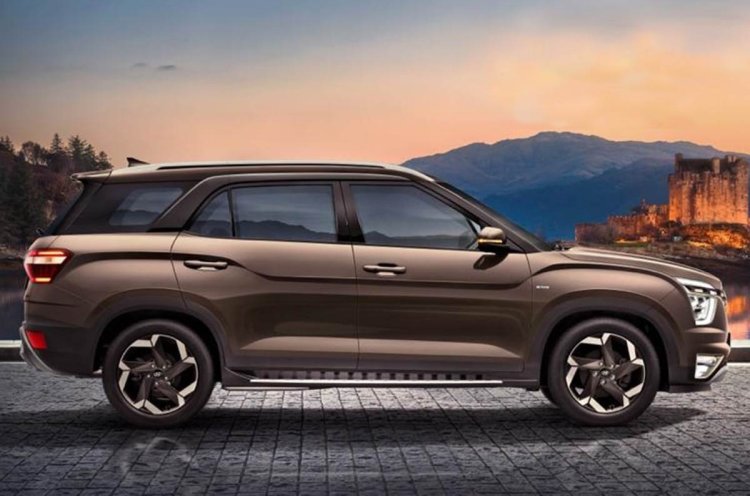Hyundai debuted the all-new Alcazar seven-seater SUV in pre-production prototype form in India yesterday. The Hyundai Alcazar is essentially a 7-seater version of the Creta and it is the brand's first three-row SUV in a really long time. While it is based on the same platform as the Creta, the Alcazar gets its own unique identity with revised styling, unique interior and seating arrangement and it even gets a new powertrain option. We had a brief experience with the prototype version of the Alcazar in Rajasthan yesterday and here's a first impression about the driving experience of the upcoming SUV. But first, let's take a look at some technical details.
Hyundai Alcazar - Platform and Engine Options
As already mentioned, the Alcazar is based on the same platform as the Creta. However, Hyundai have reworked the platform to give it a longer wheelbase of 2,760 mm, which is 150mm more than the Creta. This has obviously been done to open up more space for the third row of seats. The Alcazar also comes with a longer rear overhang to further allow for more space. It is also around 150kg heavier than the 1.4L turbo-petrol version of the Creta.
Under the hood, the Hyundai Alcazar gets the options of two engines - a 2.0L petrol and the 1.5L diesel engine. Contrary to what was previously thought, the Alcazar does not the share the exact engine options with the Creta. The petrol engines from the Creta have been swapped for a bigger 2.0L engine that does duty on the Hyundai Elantra and Tucson.

The 2.0-litre, four-cylinder petrol engine has been tuned to produce 159PS and 192Nm of peak torque. Hyundai says the Alcazar petrol can sprint from 0-100 kph in less than 10 seconds. The tried-and-tested 1.5L diesel engine has been carried over from the Creta and produces the same 115PS and 250Nm of torque. This diesel engine has been recalibrated for the bigger and heavier 7-seater SUV. Both engines come mated to either a 6-speed manual or a 6-speed automatic gearbox.
Also Read : Three-Row Mid-Size SUV Boom - What Makes It So Suitable For India?
Hyundai Alcazar - First Drive Impressions
In our brief stint with the Alcazar, we had it in its petrol manual guise. Although the 2.0-litre naturally aspirated motor is already on the Elantra and Tucson, the Alcazar gets the latest, third-generation version, which is more efficient, refined and sees a slight bump up in power by 7hp. Fist impressions about the engine is that it is extremely smooth and refined. In fact, it is notably more refined than what you will find in the Tucson. Being a naturally aspirated engine, it does not quite have the mid-range punch as turbo-petrol engines, but it delivers its power in a linear and very progressive manner.

The engine has a wide and very usable powerband and its linear power delivery masks it's speed. The Alcazar actually feels pretty powerful and quick. Hyundai claims the Alcazar can sprint from 0-100 kph in less than 10 seconds and we have no reasons to doubt that. Driving the manual version of the Alcazar petrol, we felt that the clutch pedal is on the heavier side with a long travel for the pedal. As for the gearbox itself, the shifts have a short throw and feel quite decent. We wouldn't say its the most slick, but neither is it notchy. However, this is only a pre-production vehicle and these issues could be resolved later.

As for its handling, the Alcazar feels pretty neutral. The handling isn't particularly sharp or agile, but it isn't tuned that way either. The body roll is fairly well contained around corners and the longer wheelbase and stiffer body give you lots of confidence at higher speeds. The real highlight of the Alcazar has to be its ride quality and it is really comfortable, particularly in the first and second rows. You might even want to be chauffer driven in this SUV. Overall, the Alcazar has mature dynamics which make it easy to control. Lastly, speaking about the brakes, although the Alcazar gets disc-brakes at all four corners, the stopping power is strong but certainly not the best we have seen. That said, the Alcazar does mark a notable step up over the Creta in terms of it's driving experience.
Also Read : Mahindra XUV700 First Promo Video Out; Launch in Q2 FY2022
Hyundai Alcazar - Exterior Design
The production-spec Alcazar actually has a lot in common with the Creta. Some of the body panels like the front fenders, bonnet and even all four doors are identical to that of the Creta. The most significant changes only come after the C-Pillar. Up front, the Alcazar gets a unique grille design with a diamond-studded pattern. The front bumper design too has been slightly updated. Just like the Creta, the Alcazar features plenty of chrome up front.

In profile, up until the C-Pillar, the Alcazar is pretty similar to the Creta. Beyond that, however, things change completely. The Alcazar gets a distinct rear quarter glass area and Hyundai has even managed well to retain the 'lightning arc' element of the Creta. It also seems a little more proportionate, thanks to the longer rear overhang. The sloping roofline is now gone and the tail gate is much more upright than before. It gets brand new wrap-around tail lamps and a re-profiled rear bumper with faux dual exhaust tips and a faux brushed aluminum skid plate. The SUV also rides on new stylish dual-tone 18-inch alloy wheels.
Hyundai Alcazar - Interior Design
Hyundai haven't officially revealed the interior or the feature list of the Alcazar yet. However, from design sketches seen before, we know it will be pretty similar to that of the Creta with a two-tone color scheme. Most of the equipment from the Creta is also expected to be carried over including the 10.25-inch touchscreen infotainment system with Android Auto and Apple CarPlay, Hyundai’s connected car tech, a panoramic sunroof, digital instrument cluster, wireless phone charging, automatic climate control and much more.

Hyundai have, however, revealed details about its seating configuration and that is really its main talking point. The most obvious change is the addition of a third row of seats. The Alcazar will be offered in both 6- and 7-seater configurations.
In the 6-seater variant, the Alcazar comes with captain chairs for the middle row with an unique fixed floor-mounted arm rest with cupholders and extra storage space in the middle. In the 7-seater variant, it gets a bench seat in the middle row. The seats also have a sliding function to adjust space in the third row. Access to the third row is also fairly easy, thanks to the one-touch tumble down function for the second-row seats. As for the third row seats, they get their own reclining function, individual AC vents and can also be folded flat for an increased boot space.

Hyundai Alcazar - Launch, Rivals and Expected Price
Hyundai is expected to officially launch the Alcazar in our market in the coming weeks and the prices are expected to range between INR 12-20 lakh (ex-showroom). Upon arrival, it will take on the likes of the Tata Safari, the MG Hector Plus and also the upcoming Mahindra XUV700.
Stay tuned to IndianAutosBlog.com for more Hyundai updates and other four-wheeler news.



































